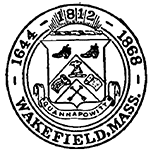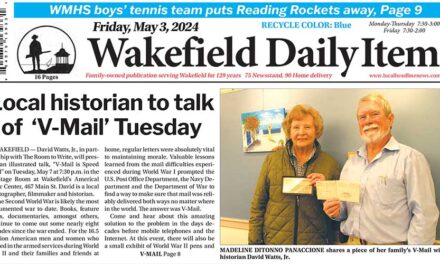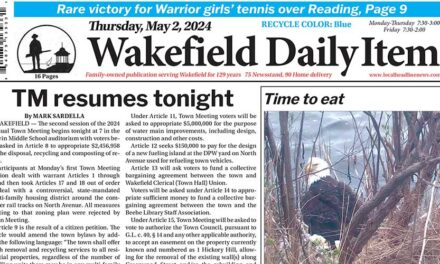Published June 17, 2020
By MARK SARDELLA
WAKEFIELD — It won’t be easy, but according to Finance Committee Chairman Daniel Sherman, the town should be able to weather all but the worst economic projections resulting from the COVID-19 shutdown. A history of sound fiscal practices along with a deliberate effort by the town over that last 20 years to be less reliant on state aid have left the town in better shape than some other communities.
With Annual Town Meeting coming up on Saturday, the town last week presented its traditional pre-Town Meeting televised financial overview, which took a somewhat different form in light of current conditions. The one-hour program aired live from the WCAT studio with Sherman, Town Administrator Stephen P. Maio and School Superintendent Douglas Lyons socially distanced from each other. It remains available for viewing on WCAT’s web site and Facebook page.
It was noted that the town’s expected property tax levy for FY 2021 is about $78.7 million. State aid is expected to be about $1 million less than originally projected, coming in at $9.7 million. Local receipts (excise tax, hotel tax and local option meal tax) are also expected to come up about $1 million short at $7.25 million.
Maio pointed out that new growth revenues are also expected to slow due to the construction slowdown over the last several months.
Sherman said that from all sources, total projected revenue for FY 2021 is expected to come in at about 97.1 million.
The town has cut its original FY 2021 budget by reducing spending in a number of areas. Capital spending has been cut in half, from $2 million to $1 million. Various town departments have also had their budgets cut. The School Department has decreased its budget request for FY 2021 by $400,000
Total expenses for FY 2021 are anticipated to be about $97.9 million. The deficit of about $932,000 can be covered this year by using Free Cash or other reserves, Sherman noted.
There are also separate articles on Saturday’s Annual Town Meeting warrant for larger capital projects, such as a $10 million long-range road maintenance plan and $1.5 million for a new roof for the Greenwood School. (The state will pick up about half of the roof cost through the Massachusetts School Building Authority.)
There was some discussion of the town’s debt service fund, which the town replenishes each year in order to make bond payments on large capital projects. It was noted that significant projects will be paid off in the next couple of years freeing up money for other projects within the town’s debt structure. Sherman said that some $60 million worth of capital projects over the next 5 years has been identified by the Capital Planning Committee.
Both Maio and Lyons talked about additional costs as a direct result of COVID-19. Maio said that it was unknown how much of these costs will be reimbursed by the state or federal government, but he expressed hope that most of it would be reimbursed.
Sherman discussed several possible scenarios for the coming year and subsequent years in light of the economic hit from COVID-19.
Under his “best case” scenario, the town will see a 10 percent drop in state aid in FY 2021 and a drop in local receipts of 12 percent. After that, he projects annual growth of 4 percent in those areas.
In his “bad case” scenario, the town would suffer a 15 percent drop in both state aid and local receipts for FY 2021, with 3 percent annual growth in the following years.
Under Sherman’s “worst case,” the town would experience 20 percent reductions in state aid and local receipts, with only 2 percent annual growth in those areas in subsequent years.
Sherman described the first two scenarios as “palatable,” as the town would be able to maintain services by spending into reserves while maintaining a reasonable reserve fund balance.
Under his “worst case” scenario, however, the town would run out of reserves in FY 2024 or 2025, Sherman said. That would mean reductions in services.
Given the economic impact of COVID-19, the town’s fiscal situation is “not as bad as I feared,” Sherman observed. “It could be, though. We’ll see.”
Maio said that it was important that the town made the cuts that it did make in order to weather the coming Fiscal Year 2021. He also said that the fact that so much of what the town spends has long been embedded in the town budget has helped tremendously.
A big question, Maio said, relates to whether municipalities will be allowed to use state and federal COVID aid money to close local revenue gaps. He said that he has been in discussions with legislators on that issue.
Annual Town Meeting is set for Saturday, June 20 at 9 a.m. in the Field House at Wakefield Memorial High School. The town’s FY 2021 budget comes up under Article 2 on the warrant.





